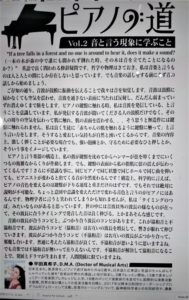 This is an English translation of an article that was published in Nikkan San on January 24, 2019. It was a part of my column, “The Way of the Pianist.
This is an English translation of an article that was published in Nikkan San on January 24, 2019. It was a part of my column, “The Way of the Pianist.
“If a tree falls in a forest and no one is around to hear it, does it make a sound?” The common query that often comes up in our everyday conversation has complicated layers that extends from philosophy to metaphysics.
Putting the physics of sound and physiology of sound perception aside, I’ve always held the view that music exists only between people. But today, I’d like to talk about sound before music.
As you know, we perceive sound when the sound waves vibrate our ear drums. Sound waves vibrate the air that it travels through. When it reaches things beside our ear drums, it bounces back if the surface is hard, or penetrates it when soft. With the distance it travels, every encounter, the waves get weaker until eventually it ceases to exit.
When I play the piano, I think about the sound waves I am generating. I think about the waves reaching not only the listener’s ear drums, but their skin, and the air around them. The awareness makes piano playing very intimate, making me approach the keys with care. I often tell my students to “touch the keys like you would a baby’s skin.” That heightens my students’ awareness on the tactile sensation of piano playing, and the sound that they produce. When the music demands a faster, harder touch, I imagine things like a passionate hug or a necessary push to save someone.
The mechanism of the piano allows my touch to transmit to the hammers that hit the strings only indirectly. If you know how many mechanical parts there are before my playing actually translates to sounds, you would be surprised that I still feel the key surfaces vibrating as the strings vibrate, generating the sound waves. Even more wondrous is the fact that even on the same piano, in the same hall, with the same piece, when the pianist changes, the instrument produces very different sounds. It is often inexplicable scientifically. The only thing that SHOULD effect the sound that comes of of a piano is the speed and the weight with which the keys go down. But there are so many variations to the tone colors that are inexplicable this way. I think there are other waves in the air that influences the way the sound wave travels and are perceived. Our bodies and emotions may generate waves, time, even the current events…all in butterfly effects creating the sound world that perceive and appreciate.
There are waves that synchronizes, creating synergy and allowing each other to travel further. In sound waves, these are consonances. Then, there are waves that clash with each other, that disturb each other. These become dissonances in sound waves. You may think that consonances are good and dissonances are bad. But in music, we need both. If you only have consonances, then it becomes static. Dissonances create momentum in the music, because of its needs for resolution. It drives the development of music, just as in any human relationships, and communications.